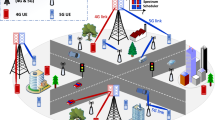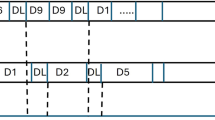Abstract
An efficient Contention Control algorithm aims to resolve contention among stations in a dynamic wireless environment. It seeks to achieve maximum throughput and low packet delay in transmission by maintaining fairness among active stations. The IEEE802.11 Binary exponential backoff algorithm (BEB) and most of the existing related algorithms never consider the current network load and hence provide unfair channel access. To mitigate these problems, an adaptive contention and congestion control (CCC) algorithm is proposed to estimate an appropriate contention window (CW) adjustments. The proposed CCC algorithm has two different mechanisms namely ConTention control and ConGestion control to effectively distinguish contention from congestion. But, BEB and most of the existing algorithms have failed to make such differentiation thereby increasing delay and collisions in saturated wireless network. The proposed CCC algorithm dynamically modifies both the lower and upper bounds of CW with respect to contention level and collision rate. An analytical model and extensive simulation study facilitate to highlight the performance enhancements of the proposed CCC algorithm in linear and random topologies. The simulation results reveal that the proposed algorithm outperforms the existing algorithms in terms of packet delivery ratio, packet loss, end-to-end delay, overheads and collision rate.






















Similar content being viewed by others
Data Availability
The authors declare that no exact code/data has been copied to carry out the research.
Code Availability
Not applicable.
References
Ali, R., Kim, S., Kim, B., & Park, Y. (2018). Design of MAC layer resource allocation schemes for IEEE 802.11ax: Future directions. IETE Technical Review, 35(1), 28–52. https://doi.org/10.1080/02564602.2016.1242387
Sami, M., Noordin, N., Khabazian, M., Hashim, F., & Shamala, S. (2016). A survey and taxonomy on medium access control strategies for cooperative communication in wireless networks: research issues and challenges. IEEE Communications Surveys & Tutorials, 18, 2493–2521. https://doi.org/10.1109/COMST.2016.2569601
Sun, X., & Dai, L. (2015). Backoff design for IEEE 802.11 DCF networks: Fundamental tradeoff and design criterion. IEEE/ACM Transactions on Networking, 23(1), 300–316. https://doi.org/10.1109/TNET.2013.2295242
Hassan, W., King, H., Ahmed, S., & Faulkner, M. (2018). Enhancement techniques of IEEE 802.11 wireless local area network distributed coordination function: A review. ARPN Journal of Engineering and Applied Sciences, 13, 1053–1062.
Panthum, T., Sittichivapark, S., & Sartthong, J.(2016). Performance analysis of EIED backoff algorithm of the IEEE 802.11 MAC under fading channel errors. In: 13th International Joint Conference on Computer Science and Software Engineering, pp 1-6.https://doi.org/10.1109/JCSSE.2016.7748877.
Balador, A., Movaghar, A., Jabbehdari, S., & Kanellopoulos, D. A. (2012). Novel contention window control scheme for IEEE 802.11 WLANs. IETE Technical Review, 29(3), 202–212. https://doi.org/10.4103/0256-4602.98862
Tatineni, M., & Rao, G. S. (2015). Development of collision alleviating DCF protocol with efficient backoff algorithm for wireless Ad hoc networks. Wireless Personal Communications, 80, 1791–1814. https://doi.org/10.1007/s11277-014-2113-4
Malekshan, K. R., Zhuang, W., & Lostanlen, Y. (2016). Coordination-based medium access control with space-reservation for wireless Ad Hoc networks. IEEE Transactions on Wireless Communications, 15(2), 1617–1628. https://doi.org/10.1109/TWC.2015.2493544
Althumali, H., Othman, M., Noordin, N., & Hanapi, Z. M. (2020). Dynamic Backoff collision resolution for massive M2M random access in cellular IoT networks. IEEE Access, 8, 201345–201359. https://doi.org/10.1109/ACCESS.2020.3036398
Yang, B., Cao, X., Omotere, O., Li, X., Han, Z., & Qian, L. (2020). Improving medium access efficiency with intelligent spectrum learning. IEEE Access, 8, 94484–94498. https://doi.org/10.1109/ACCESS.2020.2995398
Kumar, A., Verma, G., Rao, C., Swami, A., & Segarra, S. (2021). Adaptive contention window design using deep Q-learning. In : IEEE International Conference on Acoustics, Speech and Signal Processing,4950–4954,. https://doi.org/10.1109/ICASSP39728.2021.9414805
Abyaneh, A. H., Hirzallah, M., & Krunz, M. (2019). Intelligent-CW: AI-based framework for controlling contention window in WLANs. IEEE International Symposium on Dynamic Spectrum Access Networks (DySPAN), 2019, 1–10. https://doi.org/10.1109/DySPAN.2019.8935851
Lei, J., Wang, Y., & Yun, H. (2020). Decoupling-Based channel access mechanism for improving throughput and fairness in dense multi-rate WLANs. Future Internet, 12(1), 3–19. https://doi.org/10.3390/fi12010003
Kim, J., Laurenson, D., & Thompson, J. (2019). Adaptive centralized random access for collision free wireless local area networks. IEEE Access, 7, 37381–37393. https://doi.org/10.1109/ACCESS.2019.2904888
Ali, R., Shahin, N., Kim, Y., Kim, B., & Kim, S. (2018). Channel observation-based scaled backoff mechanism for high-efficiency WLANs. Electronics Letters, 54(10), 663–665. https://doi.org/10.1049/el.2018.0617
Ali, R., Shahin, N., Zikria, Y. B., Kim, B., & Kim, S. (2019). Deep reinforcement learning paradigm for performance optimization of channel observation-based MAC protocols in dense WLANs. IEEE Access, 7, 3500–3511. https://doi.org/10.1109/ACCESS.2018.2886216
Gopinath, A., Nithya, B., Mogalapalli, H., & Khanna, P. (2020). Channel status based contention algorithm for non-safety applications in IEEE802.11p vehicular network. Procedia Computer Science, 171, 1479–1488. https://doi.org/10.1016/j.procs.2020.04.158
Sun, Y., Peng, M., Zhou, Y., Huang, Y., & Mao, S. (2019). Application of machine learning in wireless networks: Key techniques and open issues. IEEE Communications Surveys & Tutorials, 21(4), 3072–3108. https://doi.org/10.1109/COMST.2019.2924243
Sartthong, J., Sittichivapak, S., Kaewpukdee, A., & Boonpikum, I. (2013). Binary exponential increment half decrement backoff algorithm for IEEE802.11 wireless LANs. in: 10th International Conference on Electrical Engineering/Electronics, Computer, Telecommunications and Information Technology, 1-6. https://doi.org/10.1109/ECTICon.2013.6559548.
Nithya, B., Ranjan, N., & Gopinath, A. (2021). Performance analysis of prioritization and contention control algorithm in wireless body area networks. Computational Journal, 64(2), 211–223. https://doi.org/10.1093/comjnl/bxaa147
Funding
The authors declare that no funding was received for this research work.
Author information
Authors and Affiliations
Corresponding author
Ethics declarations
Conflict of interest
The authors declare that they have no conflicts of interest.
Additional information
Publisher's Note
Springer Nature remains neutral with regard to jurisdictional claims in published maps and institutional affiliations.
Rights and permissions
Springer Nature or its licensor (e.g. a society or other partner) holds exclusive rights to this article under a publishing agreement with the author(s) or other rightsholder(s); author self-archiving of the accepted manuscript version of this article is solely governed by the terms of such publishing agreement and applicable law.
About this article
Cite this article
Nithya, B., Mala, C. Mathematical and Simulation Analysis of Contention Control Algorithm for Saturated Wireless Networks. Wireless Pers Commun 132, 215–243 (2023). https://doi.org/10.1007/s11277-023-10608-9
Accepted:
Published:
Issue Date:
DOI: https://doi.org/10.1007/s11277-023-10608-9




